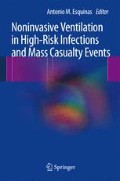Abstract
Approximately 1 % of newborn infants require neonatal transport for continuation of care [1–4]. Specialized neonatal transport teams are skilled in patient care, communication, and equipment management; and they are extensively trained in resuscitation, stabilization, and transport of critically ill infants [5–7]. Overall, 95 % of neonatal transports are by road, with air transport (helicopter or fixed-wing aircraft) accounting for only 5 % [3]. One-third of neonatal transports occur within the first 24 h after birth and the rest within the first week after birth [1–3].
GMS is supported in part by a Banting Postdoctoral Fellowship, Canadian Institute of Health Research and an Alberta Innovate – Health Solution Clinical Fellowship.
Access this chapter
Tax calculation will be finalised at checkout
Purchases are for personal use only
References
Berge S, Berg Utby C, Skogvoll E. Helicopter transport of sick neonates: a 14‐year population‐based study. Acta Anaesthesiol Scand. 2005;49:999–1003.
Fenton AC, Leslie A. The state of neonatal transport services in the UK. Arch Dis Child Fetal Neonatal Ed. 2012;97(6):F477–81.
Noone D, Bowden A, Twomey A. The National Neonatal Transport Programme (NNTP) 2004–2009. Ir Med J. 2011;104:232–4.
Lilley CD, Stewart M, Morley CJ. Respiratory function monitoring during neonatal emergency transport. Arch Dis Child Fetal Neonatal Ed. 2005;90:F82–3.
Fenton AC, Leslie A. Who should staff neonatal transport teams? Early Hum Dev. 2009;85:487–90.
Caverni V, Rastrelli M, Aufieri R, Agostino R. Can dedicated ambulances improve the efficiency of the neonatal emergency transport service? J Matern Fetal Neonatal Med. 2004;15:126–8.
Leslie A, Stephenson T. Neonatal transfers by advanced neonatal nurse practitioners and paediatric registrars. Arch Dis Child Fetal Neonatal Ed. 2003;88:F509–12.
Resnick S, Sokol J. Impact of introducing binasal continuous positive airway pressure for acute respiratory distress in newborns during retrieval: experience from Western Australia. J Paediatr Child Health. 2010;46:754–9.
Ofoegbu B, Clarke P, Robinson M. Nasal continuous positive airway pressure for neonatal back transfer. Acta Paediatr. 2006;95:752–3.
Bomont RK. Use of nasal continuous positive airway pressure during neonatal transfers. Arch Dis Child Fetal Neonatal Ed. 2006;91:F85–9.
Simpson J, Ahmed I, McLaren J, Skeoch C. Use of nasal continuous positive airway pressure during neonatal transfer. Arch Dis Child Fetal Neonatal Ed. 2004;89:F374.
Schmölzer GM, O’Reilly M, Cheung PY. Noninvasive Monitoring during Interhospital Transport of Newborn Infants. Crit Care Res Pract. 2013;632474. doi:10.1155/2013/632474. Epub 2013 Feb 24.
Bouchut JC, Van Lancker E, Christin V, Gueugniaud P-Y. Physical stressors during neonatal transport: helicopter compared with ground ambulance. Air Med J. 2011;30:134–9.
Hewitt F. An artificial “‘airway’” for use during anaesthetisation. Lancet. 1908(4407):490–1.
Guedel AE. A nontraumatic pharyngeal airway. JAMA. 1933;100:1862.
Marsh AM, Nunn JF, Taylor SJ, Charlesworth CH. Airway obstruction associated with the use of the Guedel airway. Br J Anaesth. 1991;67:517–23.
Richmond S, Wyllie J. European Resuscitation Council Guidelines for Resuscitation 2010. Resuscitation. 2010;81:1389–99.
Schmölzer GM, Olischar M, Raith W, Resch B, Reiterer F, Müller W, et al. Erstversorgung von Neugeborenen. Monatsschr Kinderheilkd. 2010;158:471–6.
O'Donnell CPF, Davis PG, Morley CJ. Use of supplementary equipment for resuscitation of newborn infants at tertiary perinatal centres in Australia and New Zealand. Acta Paediatr. 2005;94:1261–5.
Kamlin C. Oropharyngeal airway for prevention of airway obstruction during positive pressure ventilation in preterm infants < 34 weeks gestation during neonatal resuscitation. http://www.anzctr.org.au/trial_view.aspx?ID=343149
Wettstein RB, Shelledy DC, Peters JI. Delivered oxygen concentrations using low-flow and high-flow nasal cannulas. Respir Care. 2005;50:604–9.
Manley BJ, Dold SK, Davis PG, Roehr CC. High-flow nasal cannulae for respiratory support of preterm infants: a review of the evidence. Neonatology. 2012;102(4):300–8.
SUPPORT Study Group of the Eunice Kennedy Shriver NICHD Neonatal Research Network, Finer NN, Carlo WA, Walsh MC, Rich W, Gantz MG, et al. Early CPAP versus surfactant in extremely preterm infants. N Engl J Med. 2010;362:1970–9.
Morley CJ, Davis PG, Doyle LW, Brion LP, Hascoet JM, Carlin JB. Nasal CPAP or intubation at birth for very preterm infants. N Engl J Med. 2008;358:700–8.
Brain AI. The laryngeal mask – a new concept in airway management. Br J Anaesth. 1983;55:801–5.
Trevisanuto D, Parotto M, Doglioni N, Ori C, Zanardo V, Micaglio M. The Supreme Laryngeal Mask Airway™ (LMA): a new neonatal supraglottic device: comparison with Classic and ProSeal LMA in a manikin. Resuscitation. 2012;83:97–100.
Brimacombe J, Gandini D. Airway rescue and drug delivery in an 800 g neonate with the laryngeal mask airway. Paediatr Anaesth. 1999;9:178.
Fraser J, Hill C, McDonald D, Jones C, Petros A. The use of the laryngeal mask airway for inter-hospital transport of infants with type 3 laryngotracheo-oesophageal clefts. Intensive Care Med. 1999;25:714–6.
Trevisanuto D. Laryngeal mask airway for the interhospital transport of neonates. Pediatrics. 2004;115:e109–11.
Brimacombe JR, De Maio B. Emergency use of the laryngeal mask airway during helicopter transfer of a neonate. J Clin Anesth. 1995;7:689–90.
Author information
Authors and Affiliations
Corresponding author
Editor information
Editors and Affiliations
Rights and permissions
Copyright information
© 2014 Springer-Verlag Wien
About this chapter
Cite this chapter
O’Reilly, M., Schmölzer, G.M. (2014). Noninvasive Mechanical Ventilation During Neonatal Transport. In: Esquinas, A. (eds) Noninvasive Ventilation in High-Risk Infections and Mass Casualty Events. Springer, Vienna. https://doi.org/10.1007/978-3-7091-1496-4_26
Download citation
DOI: https://doi.org/10.1007/978-3-7091-1496-4_26
Published:
Publisher Name: Springer, Vienna
Print ISBN: 978-3-7091-1495-7
Online ISBN: 978-3-7091-1496-4
eBook Packages: MedicineMedicine (R0)

